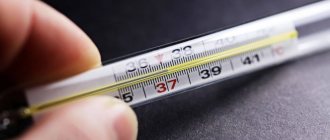"Useful" temperature
Increased body temperature (fever) is one of the main symptoms of ARVI. Viruses and toxins that are formed during inflammation act on the thermoregulation center located in the brain. As a result, it switches to a different mode of operation, changing the functioning of the cardiovascular, respiratory, nervous, endocrine and immune systems. Metabolic processes are accelerated, and this is accompanied by the formation of a large amount of thermal energy. An increase in temperature is accompanied by chills, contraction of muscles and superficial vessels of the skin. Blood rushes into the body. This prevents the body from getting rid of excess heat and contributes to the development of fever2. Despite its clearly pathological nature, fever can be considered beneficial for the body. As the temperature rises, immunity strengthens and the activity of leukocytes – white blood cells that stand in the way of microbial aggression – increases. This helps the body fight infection3.
How does the temperature rise and how long does it last for the flu?
The infection begins acutely with an increase in temperature. The patient feels chills. This is the contraction of small fibers of skeletal muscles, “producing” heat. Pyrogens act on the brain, causing a subjective feeling of cold. A person who is just getting sick with the flu is trying to warm up. Peripheral vessels narrow to reduce heat transfer. The patient notices how his hands and feet become cold.
When the temperature reaches high values, the vessels begin to expand. The chills stop and the person feels “hot.” His face turns red and sweating increases (this is the so-called “red” hyperthermia). In most patients with influenza, the fever stops at 38-39 degrees, there are no pronounced disturbances in thermoregulation. When answering the question of how long the flu fever usually lasts in such cases, infectious disease specialists point to an interval of 2 to 5 days.
On days 2-4, a cough develops, which signals that the trachea has been infected by the virus. If the immune system is weak, a secondary infection may occur. In this case, the temperature will last longer.
In more severe cases, the temperature rises to 39-40 °C within several hours. Disturbances in thermoregulation occur when, even against the background of fever, the body continues to “think” that it is cold, and heat production begins to significantly dominate over heat transfer. The arteries remain in a narrowed state, and overheating (“white” hyperthermia) develops. In addition, the influenza virus also affects the vascular walls, disrupting microcirculation, which primarily affects the brain. This condition poses a threat to the life and health of the patient and requires immediate hospitalization. It is difficult to predict how long the flu with such symptoms will last, and how long the fever will persist.
Temperature that does not need to be reduced
The fever itself is not dangerous, and if the body temperature does not exceed 38.50 C, you can not bring it down1. Another question is that this worsens overall well-being. Along with the temperature (and sometimes regardless of it), a feeling of weakness, weakness, unmotivated fatigue, drowsiness, headache and muscle aches appear3. The picture is complemented by the symptoms of ARVI: runny nose, nasal congestion, sneezing, sore and sore throat, cough and other signs of respiratory tract damage. The main emphasis should be on combating these manifestations of the disease. Complex medications, such as TheraFlu for colds and flu, help reduce the severity of symptoms4. Thanks to the combination of several active components, TheraFlu fights headaches, body aches, nasal congestion, sneezing and other manifestations of ARVI5, regardless of whether the body temperature is elevated4.
Fluctuations in temperature due to influenza
After the first clinical symptoms appear, patients note that the fever lasts up to 4-5 days. While taking medications, the temperature drops to low-grade levels, without reaching normal values. Episodes of relative increase are associated with further spread of the virus. The death of epithelial cells of the respiratory tract leads to the formation of foci of necrosis - this is how the protective barrier is destroyed.
In addition, influenza suppresses the immune system, reducing the number of white blood cells. Damaged epithelium and weak local protection create favorable conditions for the massive proliferation of opportunistic flora - a secondary bacterial infection occurs. Infectious agents such as:
- Haemophilus influenzae (or Haemophilus influenzae);
- Staphylococcus aureus (or Staphylococcus aureus);
- Streptococcus pneumoniae (or Streptococcus pneumoniae).
Therefore, microbial pneumonia is considered the most common complication of influenza. It should be considered if the patient's fever lasts longer than 5 days. Sometimes bacterial pneumonia develops earlier - 3-4 days from the onset of the disease.
It is indicated by a specific change in the temperature curve: after a short period of normalization (without the help of drugs), the patient begins to have a fever again. Therapists warn zealous workaholics about this development of events. If these patients with untreated flu strive to bring down the temperature as soon as possible and “get back to work,” they risk ending up in a hospital bed with pneumonia, pleurisy and losing their health or life.
If the temperature is low
It happens that with ARVI, the thermometer freezes at below 360C. How to feel about this and what to do? Hypothermia can be caused by excessive sweating. You need to wipe your armpit dry and measure your temperature again. A temperature reaction that is inadequate to the general condition often occurs in older people, pregnant women, and patients with severe concomitant diseases and endocrine pathologies. Sometimes the cause of hypothermia is the abuse of antipyretic drugs, so you should always strictly follow the instructions for taking the drug. Even if the temperature is normal, you should not ignore the symptoms of ARVI: the less nasal congestion and the less frequent sneezing, the less viruses will spread. The combined drug TheraFlu for colds and flu has antipyretic, anti-inflammatory, decongestant, analgesic and antiallergic effects, which helps improve well-being5 even at normal and low body temperature. In any case, if cold symptoms appear, you should consult a doctor. After all, only a specialist can adequately assess the condition and symptoms of the disease and select the necessary treatment.
Temperature 37 °C in children
Many of the causes of hyperthermia in a child are the same as in an adult. For example, children can overheat in the sun in hot weather; their nervous system, which controls the processes of heat production and heat transfer, may also be disrupted3.
In most cases, the child develops a so-called post-infectious low-grade fever, which is associated with a recent acute respiratory viral infection.
In 86% of children, low-grade fever may persist for 3-6 months after viral infection3.
Often a child has a body temperature of 37 °C for no apparent reason. This is the so-called institutional fever or “thermoneurosis”3. With “thermoneurosis,” the child usually tolerates the fever well. Parents may notice that antipyretic drugs do not give the desired effect, and the rise in body temperature is associated with psycho-emotional stress, for example, the stress that the child experiences at school3.
Up to contents
Literature
1. N.V. Orlova, T.G. Suranova. Acute respiratory diseases: clinical features, drug therapy. MEDICAL COUNCIL • No. 15, 2021. pp. 82-88. 2. V.M. Delyagin. Fever (new touches on an ancient painting). Consilium Medicum. Pediatrics. (App.) 2018; 2: pp. 89-93 3. Dvoretsky L.I. Feverish patient. Place and benefits of antipyretics. "RMZh" No. 19 dated 09/07/2011. P. 1166 4. Martynov, A., Malyavin, A., Zhuravleva, M., Bolieva, L., Esaulenko, E., Babak, S., Kalyuzhin, O. Consensus of the expert council of the RNMOT “Improving the results of treatment of respiratory tract infections » Preventive Medicine, 2021, 22(4);144-151 5. Instructions for medical use of the drug TheraFlu® for flu and colds. RU P N012063/01 dated 05/31/2011 6. Tatochenko V.K. Use of antipyretics in children. Issues of modern pediatrics. 2004, volume 3, no. 5, pp. 70-73. 7. Melnikova I.M., Mizernitsky Yu.L. Rational use of antipyretics for acute respiratory diseases in children // Medical Council - No. 2, 2021 - P. 77-81. The trademark belongs to or is used by the GlaxoSmithKline Group of Companies JSC GlaxoSmithKline Healthcare, Russia, 123112, Moscow, Presnenskaya nab., 10, premises III, room 9, floor 6,.
2. Reasons
There are a great many reasons for an increase in temperature, many of which are purely situational, but in this case, low-grade fever is always transient in nature and passes more or less quickly. These are, for example, temperature fluctuations during the day (slightly higher in the evening), in response to intense physical activity, overheating, a stressful situation, or (in women) the ovulation phase of the cycle.
An increase in temperature is one of the most common, almost always occurring reactions to an infection, no matter what pathogen it is caused by; Accordingly, persistent low-grade fever often turns out to be a symptom of a chronic infectious-inflammatory process, with which the immune system has entered into a kind of “clinch” without a clear “winner.”
The causes can also be HIV/AIDS, oncological processes, endocrine disorders (usually thyroid pathology), autoimmune diseases, asthenic conditions after an illness, anemia, viral hepatitis, chronic inflammation of the structures of the nasopharynx, kidneys, reproductive system, etc.; eroding and ulcerating diseases of the gastrointestinal tract, parasitosis, cardiovascular pathology, taking certain medications.
Visit our Therapy page
How to help the body with fever?
- Do not increase the temperature artificially.
Do not take a hot bath, do not steam your feet, do not apply mustard plasters and alcohol compresses, do not drink alcohol, hot milk, tea, coffee, do not wrap yourself in blankets.
- Drink plenty of fluids.
The drink should be plentiful and warm, maybe at room temperature, and always unsweetened. The best is mineral water with lemon, lingonberry or cranberry juice. The blood becomes more fluid, toxic substances are eliminated faster, and the body does not suffer from dehydration. Sugary drinks are dangerous because water will come out along with sweat, and glucose will become an additional source of food for pathogens.
- Sweat properly and stay in bed
Intense sweating is a natural mechanism of thermoregulation during fever. As sweat evaporates from the skin, it cools the body and prevents it from overheating. By wrapping the patient in several blankets and insulated pajamas, we prevent sweat from evaporating. A person with a fever should wear cotton clothing and lie under a light, thin blanket. When clothes get wet, they need to be changed.
- Cleanliness and fresh air.
The room should be clean and well ventilated. As a rule, a sick person breathes through his mouth, which means that an infection will quickly enter his lungs along with moist, stale air. The air temperature in the room should be approximately 22°C - 24°C. It is extremely important that there are no drafts.
- Do not wipe your body with vodka or alcohol.
Alcohol vapor evaporates very quickly and causes sudden hypothermia and severe chills. It is best to wipe the body with a sponge soaked in warm water, or put the patient in a cool bath for a while.
- Food should be light
During illness, everything fried, salty, fatty, spicy, and alcohol should be excluded from the diet. The best choice is low-fat broths, juices, fruit drinks, fresh and boiled fruits and vegetables.
How to reduce febrile fever
To get rid of malaise at high temperatures, doctors recommend taking antipyretics. The best choice is medications based on paracetamol or ibuprofen. Such medications are suitable for both adults and children.
Adult patients are offered antipyretic tablets or powders. But it is necessary to remember that at a temperature above 38 degrees, which lasts longer than 3 days, in any case you should consult a therapist. The specialist will determine the cause of hyperthermia and prescribe treatment.
When pathogenic microbes enter the body, as well as during their vital activity, a large amount of toxic substances enter the bloodstream - and the patient’s well-being worsens. To reduce intoxication during fever, you need to drink a lot of fluids - still mineral water, dried fruit compote, herbal teas and plain water. The patient can be offered linden tea, a decoction of willow bark, a drink made from raspberry shoots, and raspberry jam. You cannot limit yourself to 1-2 cups of a healing drink. To speed up the normalization of temperature, a lot of fluid must enter the body.
Febrile fever in children goes away after taking syrups with paracetamol or ibuprofen. If it is difficult for your baby to drink sweet medicine, then you can use rectal suppositories. The pediatrician should advise which medicine is suitable in your case, as well as the dosage, based on the age and weight of the baby. If the antipyretic does not work, this may mean that you purchased a counterfeit drug from the pharmacy.
Rubbing can lower the temperature slightly. For adults, use a mixture of warm water and vinegar or vodka. Children are wiped with warm water without adding alcohol or acid. To alleviate the condition of a febrile condition, applying a soaked cloth to the inside of the elbows, under the knees, to the neck - that is, to the places where large lymph nodes are located.
3. Symptoms and diagnosis
In medicine, there is a stable expression “low-grade fever without signs of a cold.” If there really are no such signs, it is very important to understand and tell the doctor what is unusual in your condition and well-being, what associated symptoms or discomfort are accompanied by persistent low-grade fever. It is impossible to list all the options; their number is almost endless and ranges from intense pain syndromes to a barely noticeable decrease in function. Changes can be found in any system or physiological process of the body - digestion, sensory organs, skin, musculoskeletal system, etc.
In some cases, to reliably establish the causes, it is enough to collect complaints and anamnesis, as well as a standard therapeutic examination with palpation, auscultation and percussion. In others, a thorough multifaceted examination may be required using laboratory tests, instrumental imaging, endoscopic and functional diagnostic methods. However, in the vast majority of cases, given the diagnostic capabilities of modern medicine, the cause is eventually found.
About our clinic Chistye Prudy metro station Medintercom page!










